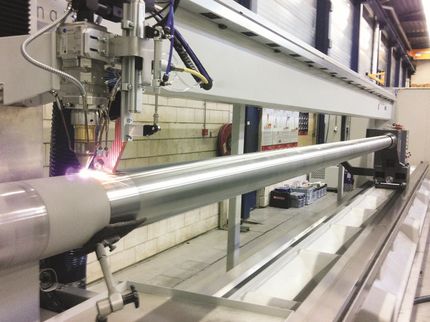The mystery of cathodic corrosion protection clarified
Two centuries of technological development
Cathodic corrosion protection is a widely used technique for protecting steel-based infrastructure from corrosion. ETH researchers have now clarified the detailed mechanisms involved, thereby resolving a controversial issue that had preoccupied the engineering community for decades.
Corrosion is a chemical reaction to which even the strongest structures fall victim. Metals such as steel react with oxygen and water, going on to rust and decay. Cathodic protection plays a key role in combatting corrosion. It protects steel structures by slowing down or preventing the processes that lead to corrosion.
Cathodic protection was first described in a scientific context in England two centuries ago and has since played a valuable role in maintaining modern infrastructure such as buried gas pipelines and reinforced concrete structures. “However, despite its widespread use, the underlying working principle behind cathodic protection has remained unclear and controversial,” says Ueli Angst, Professor of Durability of Materials at ETH Zurich.
A team of researchers led by Angst has now made significant progress in clarifying the principle behind it, particularly in the case of steel in porous media such as soil or concrete.
Their study, published in the journal Communications Materials in the Nature portfolio, sheds light on the complex processes involved in cathodic corrosion protection at the interface between the metal and the porous medium. To illustrate the interplay, it is worth taking a look at the history behind the method.
Two centuries of technological development
Cathodic corrosion protection goes back to British chemist and inventor Sir Humphry Davy, who described the principle just over two hundred years ago. Back then, the Royal Navy was facing a problem: it had clad the wooden hulls of its ships with copper sheeting to prevent fouling and rotting – but the copper hulls were quickly attacked and subject to corrosion in the salty seawater. Sir Humphry Davy, then President of the Royal Society, took up the search for a solution in the name of science.
In northern Italy, Luigi Galvani and Alessandro Volta had recently discovered the phenomenon that an electric current flows when different precious metals are joined together. Inspired by this, Davy was able to show in the laboratory that small samples of base metals such as zinc or iron can protect relatively large copper sheets from corrosion, namely by acting as a sacrificial anode and corroding themselves.
In 1824, the Royal Navy transposed Davy's technique virtually directly from the laboratory to its entire fleet – too hastily, as it turned out. Although the copper hulls were now protected against corrosion, they lost their effectiveness against marine fouling: the ships became increasingly heavy and barely manoeuvrable. The Royal Navy had to remove the cathodic corrosion protection again, and Davy's episode went down in history as a significant lesson in failure due to the premature transfer of knowledge into practice.
“Today we know that the cathodic protection current has the side effect of promoting the deposition of minerals on the metal, which allows the growth of mussels and other marine organisms,” says Angst. Despite the failure two centuries ago, Davy’s work laid the foundation for later applications.
Two hypotheses on how it works
However, it was another hundred years or so before Robert James Kuhn revived the technology in the USA, this time to make buried pipes durable. Kuhn’s notes show that he already had a much better understanding of corrosion processes in the 1920s than had been the case in Davy's time. Kuhn also carried out extensive test series “in the field”, i.e. under real-life conditions.
The technology has since developed into a standard method for corrosion protection and today ensures that water and gas pipes, tanks and ships, as well as bridges and car parks, have a longer and corrosion-free life.
However, despite its widespread use in engineering practice, the underlying mechanisms of action of cathodic corrosion protection are still the subject of controversial debate.
For decades, there have been two opposing theories: one being the view that the protective current directly influences the rate of corrosion through a purely kinetic mechanism, and the other being that it leads to an increase in the pH value in the medium at the interface, which protects the steel from corrosion – an idea first postulated by Kuhn as early as 1928.
According to Angst, the lack of a consistent scientific understanding is hindering the development of sound engineering practices. One example is the protection criterion postulated by Kuhn in the 1920s, which is still used in standards today and requires a potential of -850 millivolts in relation to the saturated copper sulphate electrode: “This is an empirical criterion,” says Angst.
The inconsistent state of knowledge also means that standards are contradictory and it is not always possible in practice to fulfil all the relevant standard specifications at the same time. “This is a serious problem in engineering and is all the more worrying given that cathodic protection can be considered a key technology for tackling the challenge of infrastructure ageing and is used in safety-relevant systems such as high-pressure gas pipelines,” continues Angst.
A unifying working mechanism
For their study, the ETH researchers focused on the interface between steel and the electrolyte and characterised the spatial and temporal changes in detail.
For the first time, they were able to demonstrate the formation of a thin metal oxide film on the steel surface and show that this layer is a direct result of the increase in pH due to the electrochemical processes taking place.
Federico Martinelli-Orlando, first author of the study, adds: “We were also able to show that these chemical changes on the steel surface and in the electrolyte lead to changes in the speed and progression of the anodic and cathodic reactions.”
The researchers propose a mechanism of action that resolves the apparent contradictions between previous hypotheses and brings the two theories together in a complementary way.
“We conclude that we should consider the two debated theories as complementary rather than contradictory in order to fully explain the working mechanism of cathodic protection,” says Martinelli-Orlando.
Based on the measurements carried out, the researchers have developed a mechanistic model that takes all electrochemical processes into account.
Consistent standards
The consistent understanding gained can help to improve corrosion protection technologies and operate critical steel-based infrastructures in a safe, economical and environmentally friendly manner.
The results can subsequently “validate” existing empirical concepts and form the basis for consistent approaches, for example, to develop well-founded standard criteria for the effectiveness of cathodic corrosion protection.
Scientifically supported technologies for corrosion protection currently play an important role, particularly in the context of ageing infrastructure, as they can delay or prevent the replacement of old structures. “If we avoid unnecessary dismantling and replacement of structures, this ultimately also benefits the environment,” says Angst.
Original publication
Federico Martinelli-Orlando, Shishir Mundra, Ueli M. Angst; "Cathodic protection mechanism of iron and steel in porous media"; Communications Materials, Volume 5, 2024-2-16
Ueli M. Angst; "A Critical Review of the Science and Engineering of Cathodic Protection of Steel in Soil and Concrete"; Corrosion, Volume 75, 2019-10-13































































